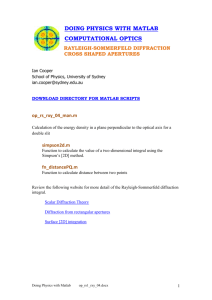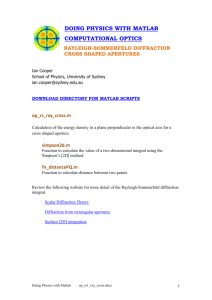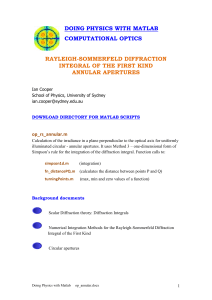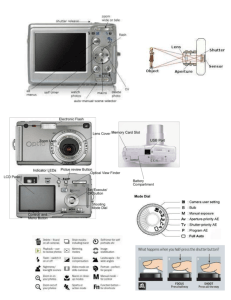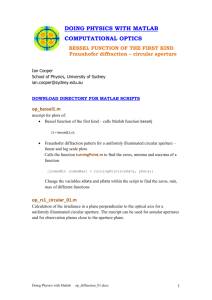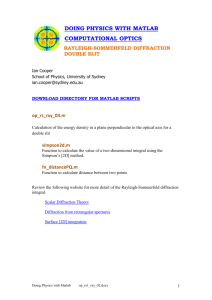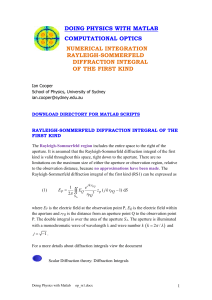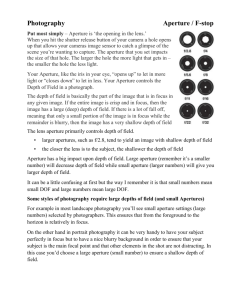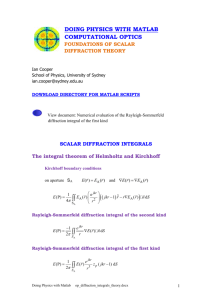op_rs_triangle
advertisement
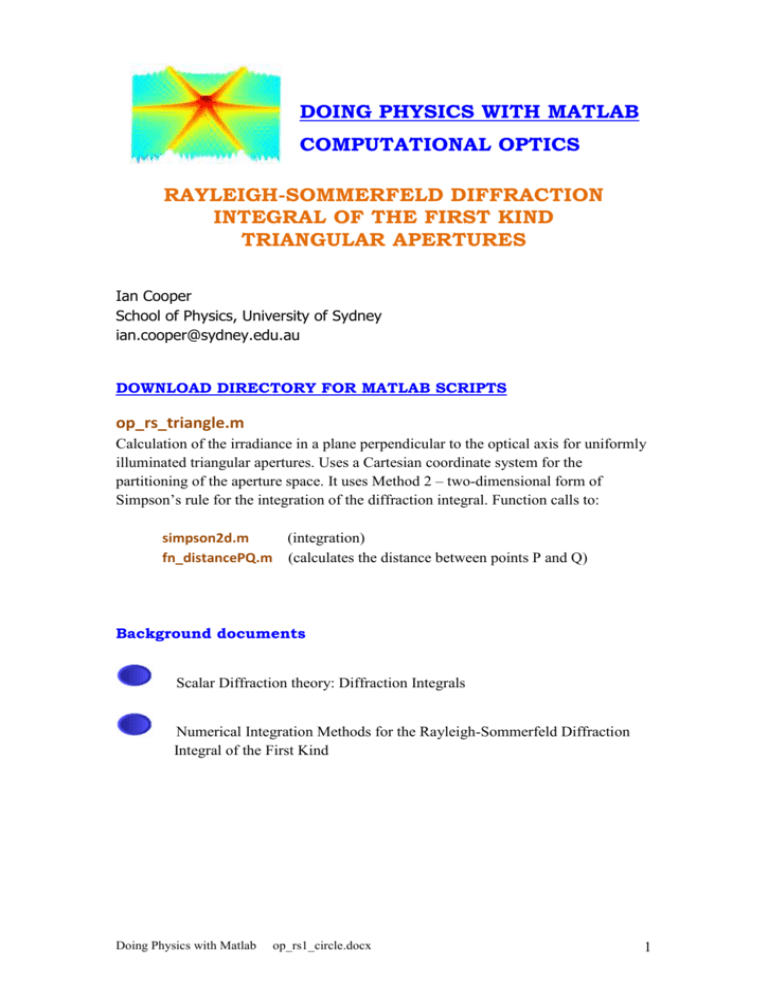
DOING PHYSICS WITH MATLAB COMPUTATIONAL OPTICS RAYLEIGH-SOMMERFELD DIFFRACTION INTEGRAL OF THE FIRST KIND TRIANGULAR APERTURES Ian Cooper School of Physics, University of Sydney ian.cooper@sydney.edu.au DOWNLOAD DIRECTORY FOR MATLAB SCRIPTS op_rs_triangle.m Calculation of the irradiance in a plane perpendicular to the optical axis for uniformly illuminated triangular apertures. Uses a Cartesian coordinate system for the partitioning of the aperture space. It uses Method 2 – two-dimensional form of Simpson’s rule for the integration of the diffraction integral. Function calls to: simpson2d.m (integration) fn_distancePQ.m (calculates the distance between points P and Q) Background documents Scalar Diffraction theory: Diffraction Integrals Numerical Integration Methods for the Rayleigh-Sommerfeld Diffraction Integral of the First Kind Doing Physics with Matlab op_rs1_circle.docx 1 RAYLEIGH-SOMMERFELD DIFFRACTION INTEGRAL OF THE FIRST KIND UNIFORMLY ILLUMINATED TRIANGULAR APERTURES The Rayleigh-Sommerfeld diffraction integral of the first kind states that the electric field at an observation point P can be expressed as E (P) (1) 1 2 E (r ) SA e jkr r3 z p ( jkr 1) dS It is assumed that the Rayleigh-Sommerfeld diffraction integral of the first kind is valid throughout the space in front of the aperture, right down to the aperture itself. There are no limitations on the maximum size of either the aperture or observation region, relative to the observation distance, because no approximations have been made. The irradiance or more generally the term intensity has S.I. units of W.m-2. Another way of thinking about the irradiance is to use the term energy density as an alternative. The use of the letter I can be misleading, therefore, we will often use the symbol u to represent the irradiance or energy density. The irradiance or energy density u of a monochromatic light wave in matter is given in terms of its electric field E by (2) u c n 0 2 E 2 where n is the refractive index of the medium, c is the speed of light in vacuum and 0 is the permittivity of free space. This formula assumes that the magnetic susceptibility is negligible, i.e. r 1 where r is the magnetic permeability of the light transmitting media. This assumption is typically valid in transparent media in the optical frequency range. The integration can be done accurately using any of the numerical procedures based upon Simpson’s rule to compute the energy density in the whole space in front of the aperture. Numerical Integration Methods for the Rayleigh-Sommerfeld Diffraction Integral of the First Kind Doing Physics with Matlab op_rs1_circle.docx 2 The aperture space is defined by assigning the electric field EQ to the maximum value at all grid points within a rectangle, then, setting values of EQ to zero at those grid points that determine the shape of the aperture’s transparent and opaque partitions. Figure (1) shows a triangular shaped aperture and its dimensions. The integration of the Rayleigh-Sommerfeld integral (equation 1) is done over the area of the rectangle using the two-dimensional form of Simpson’s rule (Method 2). % Aperture electric field EQ EQmax = sqrt(2*uQmax/(cL*nR*eps0)); EQ = EQmax .* ones(nQ,nQ); flag1 = zeros(nQ,nQ);flag2 = zeros(nQ,nQ); flag1(yQ > -(ay/2).*(xQ./ax - 1)) = 1; flag2(yQ < (ay/2).*(xQ./ax - 1)) = 1; EQ(flag1+flag2 == 1) = 0; Fig. 1. A triangular shaped aperture. The yellow corresponds to the transparent partition and the blue to the opaque partition of the aperture space. Figure (2) shows the variation of the irradiance (energy density) along the X-axis (blue) and Y-axis (red). Figures (3) and (4) shows the diffraction pattern in the XYplane for scaled values of the irradiance (energy density). Doing Physics with Matlab op_rs1_circle.docx 3 Fig. 2. Energy density variations along the X-axis (blue) and Y-axis (red). Fig. 3. Diffraction pattern for a triangular aperture. Doing Physics with Matlab op_rs1_circle.docx 4 Fig. 4. Diffraction pattern for a triangular aperture. Parameter summary [SI units] wavelength [m] = 6.5e-07 nQ = 159 nP = 401 Aperture Space X width [m] = 1.300e-05 Y width [m] = 1.300e-05 Observation Space X width [m] = 2.600e-03 Y width [m] = 2.600e-03 distance aperture to observation plane [m] zP = 3.900e-03 Elapsed time is 196.541442 seconds. Doing Physics with Matlab op_rs1_circle.docx 5
